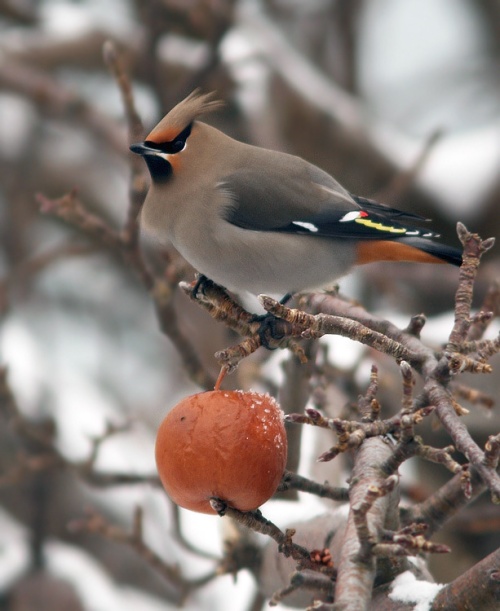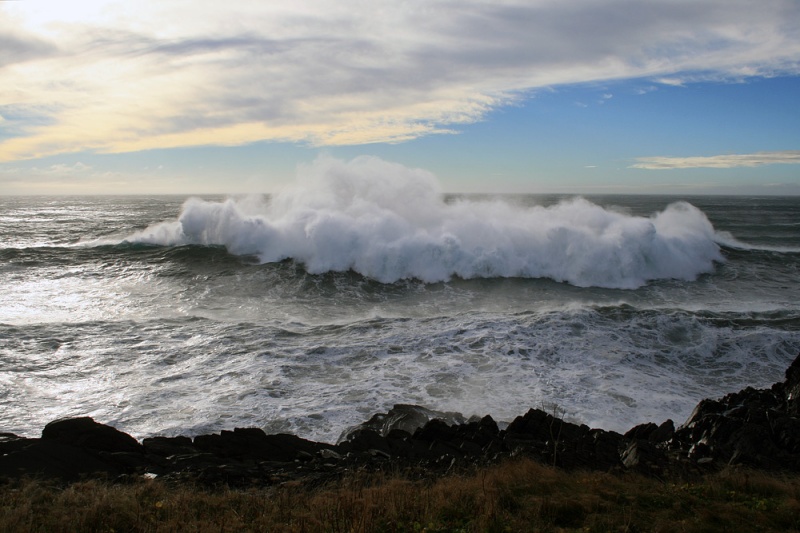Winter is a fun and special time to go birding in Newfoundland – which is why a group of WINGS tour participants brave the cold weather to visit here every January. This year, just two intrepid birders made the trip – from two very different parts of the United States, Maryland and Washington state! And I had the pleasure of sharing the wonderful birds & beautiful scenery of the eastern Avalon Peninsula with them.
We started the five-day tour with a visit to Cape Spear – the easternmost point in North America and a perfect place to spot some of our main targets for the week. It didn’t take long to find the local flock of Purple Sandpipers, first fluttering past the point and then taking shelter among the jagged rock jetties. A few small flocks of Common Eider flew by during our visit, and a group of ~40 Long-tailed Ducks bobbed up and down in the distance. An immature Peregrine Falcon (of the northern tundrius race) appeared out of nowhere, briefly checking us out before disappearing over the nearby hills. We even found six Dovekie quite close to the rocks below us. But the real highlight was finding another Dovekie actively feeding just metres from the shoreline at Blackhead village – it paid little attention to us as we sat on the snow-covered beach and soaked in the close-up views and photo opportunities!

Dovekie are always a big hit on winter tours, and this one really entertained as it fed in the shallow waters just metres away.
The rest of the first two days were spent birding in St. John’s, where we enjoyed the full smorgasbord of exciting winter birds that the city has to offer. Among the nine species of duck hanging out in local ponds, the dozens of Tufted Ducks were a hands-down favourite. Both American and the much rarer Eurasian Green-winged Teals were seen, allowing for great comparisons of these two surprisingly unique subspecies. We enjoyed point blank looks at Great Cormorant in the harbour, as well as a very confiding adult Peregrine Falcon perched in a tree overlooking Quidi Vidi lake. We even tracked down a very late and out-of-place Pine Warbler that has been hanging out in Bowring Park!

This adult Peregrine Falcon has been hanging out near Quidi Vidi lake and provided great looks for our WINGS participants!

The classy looking Tufted Duck is another popular bird with visitors, and we saw nearly 70 this past week!

We found this drake Common (aka Eurasian Green-winged) Teal in a small city brook. I consider this a “pocket species”, since maybe it will be split someday.

Among the 100+ divers hanging out in St. John’s is this odd-looking bird thought to be a Ring-necked Duck X Scaup hybrid. Cool!

This Pine Warbler is out of its element here in the middle of our winter, but seems to be doing okay for itself thanks to a few helpful birders keeping the park stocked with food.

It’s difficult to ignore the beautiful winter scenery of North America’s oldest city, even when you’re busy birding.
Gulls are an essential part of any winter tour in Newfoundland, and this week did not disappoint. We soaked in great looks and photo opportunities with thousands of Herring, Great Black-backed and “Kumlien’s” Iceland Gulls, several hundred Glaucous Gulls, dozens of Black-headed Gulls (a key target for the tour!), a handful of Lesser Black-backed Gulls, and two Common (aka European Mew) Gulls! It was a great learning experience for both participants, who are now set to find and identify these rare northern visitors closer to home.

Visitors are often amazed at the variation among our wintering Iceland Gulls. The vast majority are of the “Kumlien’s” race, but every now and then we encounter a candidate “glaucoides”, like this one. Note the pure white wingtips and paler mantle compared to the more typical Kumlien’s Gulls in the background.
The third day brought beautiful (though cold!) weather, so we headed off to bird the beautiful coast of the southeast Avalon. Our first big highlight was finding three White-winged Crossbills feeding in a white spruce at Ferryland … a special and somewhat unexpected treat in what has been a sparse year for northern finches. Both the birds and the light cooperated for excellent photo opportunities, making for two happy participants and one very delighted guide!

This is one of three immature White-winged Crossbills we came across, feasting on the abundant white spruce cones. Most other conifers have had a poor cone crop this year.
Among other highlights were six Snow Buntings, a lingering Fox Sparrow, a very uncommon Horned Grebe and three more Dovekie. We were excited to find that, due to a relative lack of snow cover, we were able to drive the entire length of coastal road to Cape Race. Along the way we spotted three Snowy Owls on the tundra and at least fifteen Red-necked Grebes bobbing on the water. A large mixed flock of birds below the lighthouse consisted of ~320 White-winged Scoter, one Surf Scoter, a hundred Common Eider, two hundred Common Murre and at least five Thick-billed Murre.
The next day we headed north to Conception Bay, where ducks were the order of the day. We tallied a dozen species in the various harbours and inlets along the way, including 19 Eurasian Wigeon, 2 American Wigeon, 250 Greater Scaup, 50+ Common Goldeneye, 10 Bufflehead and dozens of both Common and Red-breasted Merganser. A pair of American Wigeon X Mallard hybrids were also noted (they have been hanging out in the area for several winters now).

Most scaup in Newfoundland are Greater Scaup, but careful observers can often pick out a Lesser Scaup or two (like this one).
The last day of this WINGS tour was spent around St. John’s, including another trip to Cape Spear. A much larger concentration of Common Eiders had built up since our earlier visit – with more than 800 spread out in three main flocks. Despite the much heavier, rolling seas we were able to spot a drake King Eider in one of the flocks – a great addition to the week and yet another lifer for one participant! On the way back to town, we picked up five Pine Grosbeaks flying over our heads, a Mourning Dove on a wire and eight Evening Grosbeak at a feeder we had (unsuccessfully) staked out earlier in the week. Our last new species for the week was an adult Bonaparte’s Gull cavorting with Black-headed Gulls in St. John’s harbour. We ended the tour on a high note with a confiding flock of ~100 Bohemian Waxwings feeding in an apple tree at eye level, four very cooperative Great Cormorants, and some very tame Boreal Chickadees eating seed right out of our hands – all great photo opportunities!

A walk in the woods this time of year can prove very quiet, although on this trail we did come across a few Boreal Chickadees and five Pine Grosbeak flying overhead.

Great Cormorant often hang out in St. John’s harbour – sometimes with a very neat and historic backdrop.

A major highlight of our week was finding a flock of Bohemian Waxwings in the historic Battery neighbourhood With about one hundred birds and maybe seven apples, there quite a ruckus at times!
 It was a fantastic week spent enjoying great birds & amazing scenery with some wonderful people. What more can I ask?!?!
It was a fantastic week spent enjoying great birds & amazing scenery with some wonderful people. What more can I ask?!?!





















































